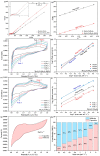PPy-Coated Mo3S4/CoMo2S4 Nanotube-like Heterostructure for High-Performance Lithium Storage
- PMID: 38202816
- PMCID: PMC10780578
- DOI: 10.3390/molecules29010234
PPy-Coated Mo3S4/CoMo2S4 Nanotube-like Heterostructure for High-Performance Lithium Storage
Abstract
Heterostructured materials show great potential to enhance the specific capacity, rate performance and cycling lifespan of lithium-ion batteries owing to their unique interfaces, robust architectures, and synergistic effects. Herein, a polypyrrole (PPy)-coated nanotube-like Mo3S4/CoMo2S4 heterostructure is prepared by the hydrothermal and subsequent in situ polymerization methods. The well-designed nanotube-like structure is beneficial to relieve the serious volume changes and facilitate the infiltration of electrolytes during the charge/discharge process. The Mo3S4/CoMo2S4 heterostructure could effectively enhance the electrical conductivity and Li+ transport kinetics owing to the refined energy band structure and the internal electric field at the heterostructure interface. Moreover, the conductive PPy-coated layer could inhibit the obvious volume expansion like a firm armor and further avoid the pulverization of the active material and aggregation of generated products. Benefiting from the synergistic effects of the well-designed heterostructure and PPy-coated nanotube-like architecture, the prepared Mo3S4/CoMo2S4 heterostructure delivers high reversible capacity (1251.3 mAh g-1 at 300 mA g-1), superior rate performance (340.3 mAh g-1 at 5.0 A g-1) and excellent cycling lifespan (744.1 mAh g-1 after 600 cycles at a current density of 2.0 A g-1). Such a design concept provides a promising strategy towards heterostructure materials to enhance their lithium storage performances and boost their practical applications.
Keywords: CoMo2S4; Mo3S4; heterostructure; lithium-ion batteries; nanostructure design.
Conflict of interest statement
The authors declare no conflicts of interest.
Figures






Similar articles
-
Efficient Regulation of Polysulfides by Anatase/Bronze TiO2 Heterostructure/Polypyrrole Composites for High-Performance Lithium-Sulfur Batteries.Molecules. 2023 May 23;28(11):4286. doi: 10.3390/molecules28114286. Molecules. 2023. PMID: 37298762 Free PMC article.
-
Realizing Ultrahigh Cycle Life Anode for Sodium-Ion Batteries through Heterostructure Design and Introducing Electro Active Polymer Coating.ACS Appl Mater Interfaces. 2024 Oct 9;16(40):54028-54037. doi: 10.1021/acsami.4c13139. Epub 2024 Sep 30. ACS Appl Mater Interfaces. 2024. PMID: 39348096
-
Critical thickness of a surface-functionalized coating for enhanced lithium storage: a case study of nanoscale polypyrrole-coated FeS2 as a cathode for Li-ion batteries.Nanoscale. 2019 Sep 21;11(35):16277-16283. doi: 10.1039/c9nr05523a. Epub 2019 Aug 28. Nanoscale. 2019. PMID: 31455958
-
Polypyrrole-coated sodium manganate microspheres cathode for superior performance Sodium-ion batteries.J Colloid Interface Sci. 2024 Nov 15;674:428-436. doi: 10.1016/j.jcis.2024.06.197. Epub 2024 Jun 26. J Colloid Interface Sci. 2024. PMID: 38941935
-
Emerging of Heterostructure Materials in Energy Storage: A Review.Adv Mater. 2021 Jul;33(27):e2100855. doi: 10.1002/adma.202100855. Epub 2021 May 25. Adv Mater. 2021. PMID: 34033149 Review.
Cited by
-
Exploring the Influence of Morphology on Bipolaron-Polaron Ratios and Conductivity in Polypyrrole in the Presence of Surfactants.Molecules. 2024 Mar 7;29(6):1197. doi: 10.3390/molecules29061197. Molecules. 2024. PMID: 38542834 Free PMC article.
-
Inhibition of programmed cell death by melanoma cell subpopulations reveals mechanisms of melanoma metastasis and potential therapeutic targets.Discov Oncol. 2025 Jan 20;16(1):62. doi: 10.1007/s12672-025-01789-9. Discov Oncol. 2025. PMID: 39832036 Free PMC article.
-
In Situ Hybridization Strategy Constructs Heterogeneous Interfaces to Form Electronically Modulated MoS2/FeS2 as the Anode for High-Performance Lithium-Ion Storage.Molecules. 2024 Mar 20;29(6):1387. doi: 10.3390/molecules29061387. Molecules. 2024. PMID: 38543023 Free PMC article.
-
The factors affecting the development of medicinal plants from a value chain perspective.Planta. 2024 Mar 31;259(5):108. doi: 10.1007/s00425-024-04380-8. Planta. 2024. PMID: 38555562 Review.
-
Charge Storage Properties of Ferrimagnetic BaFe12O19 and Polypyrrole-BaFe12O19 Composites.Molecules. 2024 Apr 25;29(9):1979. doi: 10.3390/molecules29091979. Molecules. 2024. PMID: 38731470 Free PMC article.
References
-
- Choi D., Shamim N., Crawford A., Huang Q., Vartanian C.K., Viswanathan V.V., Paiss M.D., Alam M.J.E., Reed D.M., Sprenkle V.L. Li-ion battery technology for grid application. J. Power Sources. 2021;511:230419. doi: 10.1016/j.jpowsour.2021.230419. - DOI
-
- Demirocak D., Srinivasan S., Stefanakos E. A Review on Nanocomposite Materials for Rechargeable Li-ion Batteries. Appl. Sci. 2017;7:731. doi: 10.3390/app7070731. - DOI
-
- Miao Y., Hynan P., von Jouanne A., Yokochi A. Current Li-Ion Battery Technologies in Electric Vehicles and Opportunities for Advancements. Energies. 2019;12:1074. doi: 10.3390/en12061074. - DOI
-
- Xie J., Liu G., Li X., Liu Z., Sun J., Gao S. Amorphous carbon and carbon nanotubes synergistically reinforced with MnO2 as a cathode material for zinc-ion batteries. Diam. Relat. Mater. 2023;132:109615. doi: 10.1016/j.diamond.2022.109615. - DOI
Grants and funding
LinkOut - more resources
Full Text Sources

